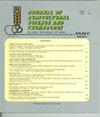Analysis of Occurrence Pattern of the Pear Psylla, Cacopsylla pyricola, in the Pear Exporting Complex
IF 1.3
4区 农林科学
Q2 AGRICULTURE, MULTIDISCIPLINARY
引用次数: 2
Abstract
One of the most serious insect pests for pear is the pear psylla, Cacopsylla pyricola Foerster (Hemiptera: Psyllidae). Due to the nature of the overwintering adults that spend winter time underneath bark the control of the pear psylla is very difficult. Thus, one of the effective control methods recommended includes a spray of machine oil emulsion, when overwintering adults start to move upward to tree branches and when eggs that have been oviposited by overwintered adult females are observed. Previously, the model that predicts the onset date of upward-movement and oviposition has been proposed on the basis of weather and ecological information of the pear psylla, but it based the information obtained from the central region of Korea, requiring the data from the southern part of Korea that is warmer than central region. In this study, therefore, we investigated annual occurrence of the pear psylla by weekly field observation and meteorological data obtained by automatic weather station (AWS) that has been installed at Bonghwang in Naju City. As a result, we found 14 days difference for the onset of upward-movement at maximum and 7 days difference for the first observation of eggs at Naju City compared with the existing prediction. Consequently, additional study for prediction model and resultant modification of the control strategy is needed, targeting the pear psylla populations occurring in southern region of Korea.梨出口园区梨木虱(Cacopsylla pyricola)发生格局分析
梨的主要害虫之一是梨木虱(半翅目:木虱科)。由于越冬成虫在树皮下过冬的性质,控制梨木虱是非常困难的。因此,建议的有效控制方法之一是,当越冬的成虫开始向上移动到树枝上,当观察到越冬的成年雌虫产卵时,喷洒机械油乳剂。此前提出了以梨木虱的天气和生态信息为基础,预测其向上运动和产卵开始日期的模型,但该模型基于韩国中部地区的信息,需要韩国南部比中部地区更温暖的数据。因此,本研究利用每周野外观测和罗州市凤黄自动气象站(AWS)的气象资料,对梨木虱的年发生情况进行了调查。结果表明,与已有的预测相比,罗州市首次观测卵的最大上升开始时间相差14天,首次观测卵的时间相差7天。因此,针对韩国南部地区发生的梨木虱种群,需要进一步研究预测模型和相应的控制策略。
本文章由计算机程序翻译,如有差异,请以英文原文为准。
求助全文
约1分钟内获得全文
求助全文
来源期刊

Journal of Agricultural Science and Technology
AGRICULTURE, MULTIDISCIPLINARY-
CiteScore
1.90
自引率
8.30%
发文量
0
审稿时长
4.5 months
期刊介绍:
Journal of Agricultural Science and Technology is one of the TMU Press journals that is published by the responsibility of its Editor-in-Chief and Editorial Board in the determined scopes.
Journal of Agricultural Science and Technology (JAST) is an international research journal published bimonthly for the purpose of advancing the scientific studies. The subjects covered by JAST include all aspects of agriculture and natural resources (see Areas Covered). The journal will consider submissions from all over the world, on research works not being published or submitted for publication towards publication as full paper, review article and research note. The Papers are published in English with an extra abstract in Persian.
 求助内容:
求助内容: 应助结果提醒方式:
应助结果提醒方式:


